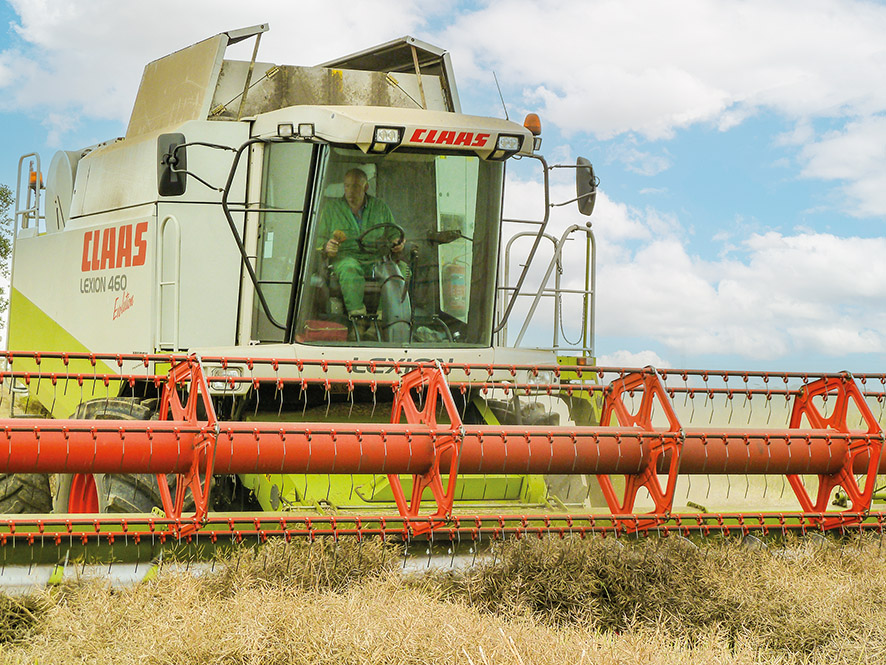Genetics: Protecting oilseed rape yields at harvest
2nd August 2022
Losses in the period up to harvest in oilseed rape can often be high. However, there are several ways that these can be kept to a minimum, says Liam Wilkinson, development officer for arable crops for Limagrain UK.
“Choosing to grow a variety with built in pod shatter resistance is one of the most important things you can do,” Mr Wilkinson says.
“Last year, some crops were devastated by storms whilst others appeared relatively unscathed, which showed very clearly, the value of pod shatter resistance.”
Pod shatter is a natural process for seed dispersion in oilseed rape; however, on farm it can result in significant seed loss caused by heavy wind, rain, hailstones, or the combine passing through the crop.
The pod shatter (POSH) resistance gene was originally introduced into OSR together with the restorer gene from radish. Not all hybrids carry POSH resistance as the trait can be lost in the breeding process to improve the restorer.
Pod shatter is not an either/or trait, but one that can be quantified by the force required to break a ripe pod, points out Mr Wilkinson
“At Limagrain, we precisely quantify pod shatter resistance using lab-based techniques, where the force required to shatter the pod is measured, and this clearly shows that not all POSH resistant varieties offer the same level of resistance,” he says.
“All of our hybrids contain the trait and we constantly monitor the efficacy of our pod shatter resistance against other commercial varieties so we can be confident in our claims that the variety really is pod shatter resistant.
“Limagrain varieties that carry the trait are LG Auckland, Ambassador, LG Aviron, Aurelia, Antigua, Artemis, LG Antigua and Clearfield variety Constructor and this plays out in their high yields and subsequent leading position on the current AHDB Recommended List.
“POSH resistance can also help to provide some flexibility in the timing of the harvest, which can be as much as 14 days extra in our tests,” he says.
“In addition, a robust POSH resistance cuts down the number of volunteers in the following crop, easing the burden of weed control.
It is also relevant to look at the overall stem health of a variety as a lodged crop is not going to be easy to harvest, adds Mr Wilkinson.
Of the diseases that can affect the health of the stem he believes that light leaf spot is the biggest threat.
“Previously considered a disease of the north, this is no longer the case as a result of mutations and a reduction in azole efficacy, alongside milder winter weather has resulted in it spreading across the UK.
“Varieties offer good light leaf disease resistance ratings on the AHDB RL, but it’s important to recognise that in the UK, light leaf spot on the stem is not something that is scored for in the AHDB RL, it’s only the leaves that are scored for disease,” he says.
“Varieties with similar light leaf scores on the AHDB RL, will in reality have very different stem health scores.
“So incidences of stem infection often go unreported, resulting in unnecessary yield and quality reductions.
“But it’s been a key focus for us across the Limagrain European breeding programme. We select plants with good strong stems that stand well as a matter of course,” he adds.
”In France, stem-based light leaf spot, or Cylindrosporium, is recognised to be a serious disease of oilseed rape in its own right and is included in the Terres Inovia Recommended List, the French equivalent of the AHDB RL.”
All of Limagrain’s varieties currently on the RL have been scored for cylindrosporium in the breeder’s own trials, as well as for LLS in the RL programme.
To illustrate this, Mr Wilkinson refers to Limagrain trials carried out in 2020.
“We evaluated the stem health of several varieties that all held the same light leaf spot score of 7 on the AHDB RL (1 being clean, through to 9 which was fully diseased).
“Aurelia was scored an excellent score of 2 for overall stem health, Ambassador and LG Aviron scored a very good 3, but one variety only scored a 6 despite also holding a light leaf spot rating of 7!
“The important message here is to look behind the headline scores and don’t assume that a good overall light leaf spot score translates into a good stem health score.
“So the first step in protecting harvest losses is having the right genetics,” notes Mr Wilkinson. “In doing so this then provides an excellent foundation for management practices such as pod stick and timing desiccation correctly, to bring an additional level of protection which ensures that every seed possible gets into the combine.”

